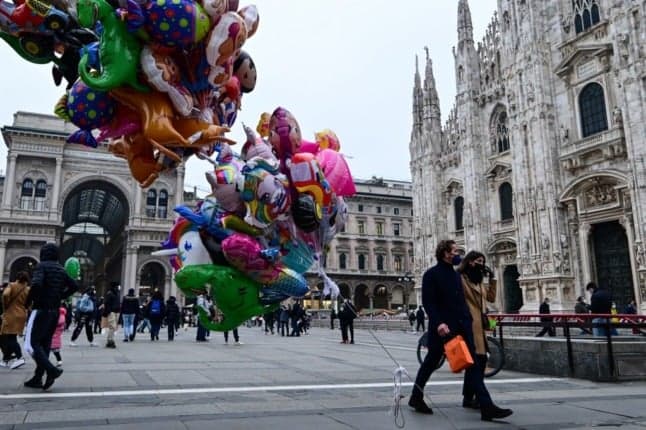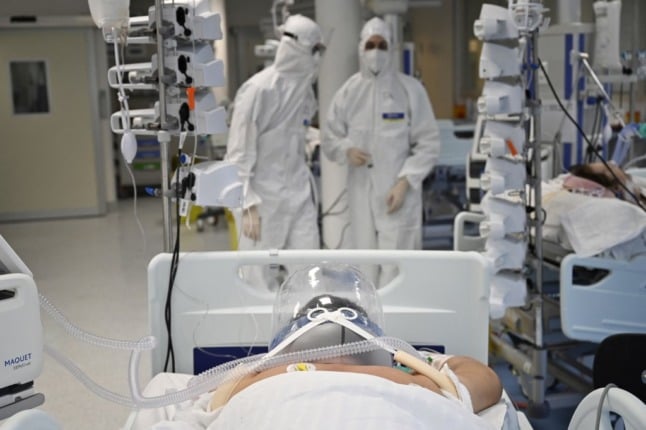Four Italian regions risk becoming 'orange' zones as Covid cases hit record high

Italy marked a record of over 170,000 coronavirus cases in one day on Tuesday, pushing some regions closer to becoming a higher risk 'orange' zone.
Covid cases, admissions to hospital and ICU have increased in almost all Italian regions, with at least four now approaching the parameters to become a higher risk 'orange' zone - Liguria, Calabria, Marche and the autonomous province of Trento.
Never in Italy have so many positive cases been reported in a single day since the start of the pandemic, as Italian authorities recorded some 170,844 new Covid infections on Tuesday.
As cases soar, admissions to ordinary wards and intensive care units have risen too, increasing pressure on hospitals across the country.
Q&A: What are Italy’s new Covid quarantine rules?
In the last 24 hours, Italy saw 579 new admissions to ordinary wards and 41 to intensive care, while deaths reached 259 - a number not seen since last April, according to the latest health figures.
The figures come after a further four Italian regions left the 'white' zone, becoming a 'yellow' zone on Monday - a total of 11 Italian regions or autonomous provinces are currently moderate-risk 'yellow' zones.
From next Monday, four of these regions could face tighter restrictions and move into an 'orange' zone due to the mounting pressure on their hospitals.
To move from a yellow to an orange zone, a region must record a weekly incidence of infection rate of 150 or more per 100,000 inhabitants and to have simultaneously exceeded the occupancy limits for general and intensive care beds in the yellow zone. That means over 20 percent occupancy for ICU beds and 30 percent for general hospital admissions.
Liguria has already reached both of the risk thresholds set by the monitoring system: it has 21 percent of its beds occupied in intensive care and 31 percent in ordinary admissions, according to the latest data provided by Agenas, Italy’s National Agency for Health Services.
Calabria has exceeded the threshold of general admissions with 32 percent occupancy, while it is still at 15 percent in intensive care.
Meanwhile, Marche is above the threshold in intensive care at 21 percent but under for ordinary hospital admissions at 23 percent. Trento is close to exceeding the threshold with 20 percent intensive care occupancy while general wards are at 19 percent occupancy. "At this rate, unfortunately, I see the risk of the orange zone as inevitable for our region," said the Marche's governor Francesco Acquaroli in reference to the region's numbers.

Photo by Alberto PIZZOLI / AFP
Should these regions move into an 'orange' zone, this would effectively mean a lockdown for the unvaccinated (or those who haven't recovered from Covid). Without a 'super green pass', this group would be denied access to public transport and almost all closed places.
Italy’s ‘reinforced’ or ‘super’ green pass – which shows proof of vaccination status or recovery from Covid-19 – is already required to access many places previously accessible to the unvaccinated via a negative Covid test, but restrictions are expected to be tightened further.
Calendar: When do Italy’s Covid-19 rules change?
The health certificate is due to be a requirement at even more places from January 10th. This includes all restaurants and bars, all public transport, including local buses, hotels, ski lifts, indoor swimming pools, wellness centres, gyms and team sports facilities; spas, museums and exhibitions, theme parks, indoor recreational centres and bingo halls.
The restrictions would come in addition to the 'orange' zone rule of not being able to move from your municipality of residence unless it's for reasons of work, necessity or urgency, although those with a basic or super green pass are exempt from this.
For some, therefore, it effectively means going backwards two years to the start of the pandemic.
Those who haven't got immunised against Covid in an 'orange' zone would only be allowed to go to public offices and shops (except shopping centres on public holidays and pre-festive days such as the evening before), since activities and events would only be open for those vaccinated or recovered from Covid-19.
The rising figures over recent weeks overall have prompted the government to consider tightening restrictions further.
Authorities are due to meet on Wednesday to discuss extending the 'super green pass' requirement to all workplaces and to make changes to the Covid protocol in school, including new quarantine requirements and when distance learning would be activated.
See the latest news and updates from The Local on Italy’s current Covid-19 health measures and travel restrictions.
For further details about Italy’s current Covid-19 health measures please see the Italian Health Ministry’s website (available in English).
Comments
See Also
Covid cases, admissions to hospital and ICU have increased in almost all Italian regions, with at least four now approaching the parameters to become a higher risk 'orange' zone - Liguria, Calabria, Marche and the autonomous province of Trento.
Never in Italy have so many positive cases been reported in a single day since the start of the pandemic, as Italian authorities recorded some 170,844 new Covid infections on Tuesday.
As cases soar, admissions to ordinary wards and intensive care units have risen too, increasing pressure on hospitals across the country.
Q&A: What are Italy’s new Covid quarantine rules?
In the last 24 hours, Italy saw 579 new admissions to ordinary wards and 41 to intensive care, while deaths reached 259 - a number not seen since last April, according to the latest health figures.
The figures come after a further four Italian regions left the 'white' zone, becoming a 'yellow' zone on Monday - a total of 11 Italian regions or autonomous provinces are currently moderate-risk 'yellow' zones.
From next Monday, four of these regions could face tighter restrictions and move into an 'orange' zone due to the mounting pressure on their hospitals.
To move from a yellow to an orange zone, a region must record a weekly incidence of infection rate of 150 or more per 100,000 inhabitants and to have simultaneously exceeded the occupancy limits for general and intensive care beds in the yellow zone. That means over 20 percent occupancy for ICU beds and 30 percent for general hospital admissions.
Liguria has already reached both of the risk thresholds set by the monitoring system: it has 21 percent of its beds occupied in intensive care and 31 percent in ordinary admissions, according to the latest data provided by Agenas, Italy’s National Agency for Health Services.
Calabria has exceeded the threshold of general admissions with 32 percent occupancy, while it is still at 15 percent in intensive care.
Meanwhile, Marche is above the threshold in intensive care at 21 percent but under for ordinary hospital admissions at 23 percent. Trento is close to exceeding the threshold with 20 percent intensive care occupancy while general wards are at 19 percent occupancy. "At this rate, unfortunately, I see the risk of the orange zone as inevitable for our region," said the Marche's governor Francesco Acquaroli in reference to the region's numbers.

Should these regions move into an 'orange' zone, this would effectively mean a lockdown for the unvaccinated (or those who haven't recovered from Covid). Without a 'super green pass', this group would be denied access to public transport and almost all closed places.
Italy’s ‘reinforced’ or ‘super’ green pass – which shows proof of vaccination status or recovery from Covid-19 – is already required to access many places previously accessible to the unvaccinated via a negative Covid test, but restrictions are expected to be tightened further.
Calendar: When do Italy’s Covid-19 rules change?
The health certificate is due to be a requirement at even more places from January 10th. This includes all restaurants and bars, all public transport, including local buses, hotels, ski lifts, indoor swimming pools, wellness centres, gyms and team sports facilities; spas, museums and exhibitions, theme parks, indoor recreational centres and bingo halls.
The restrictions would come in addition to the 'orange' zone rule of not being able to move from your municipality of residence unless it's for reasons of work, necessity or urgency, although those with a basic or super green pass are exempt from this.
For some, therefore, it effectively means going backwards two years to the start of the pandemic.
Those who haven't got immunised against Covid in an 'orange' zone would only be allowed to go to public offices and shops (except shopping centres on public holidays and pre-festive days such as the evening before), since activities and events would only be open for those vaccinated or recovered from Covid-19.
The rising figures over recent weeks overall have prompted the government to consider tightening restrictions further.
Authorities are due to meet on Wednesday to discuss extending the 'super green pass' requirement to all workplaces and to make changes to the Covid protocol in school, including new quarantine requirements and when distance learning would be activated.
See the latest news and updates from The Local on Italy’s current Covid-19 health measures and travel restrictions.
For further details about Italy’s current Covid-19 health measures please see the Italian Health Ministry’s website (available in English).
Join the conversation in our comments section below. Share your own views and experience and if you have a question or suggestion for our journalists then email us at [email protected].
Please keep comments civil, constructive and on topic – and make sure to read our terms of use before getting involved.
Please log in here to leave a comment.